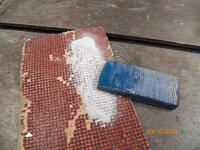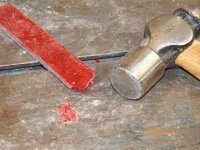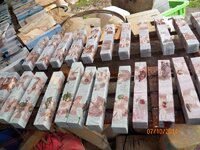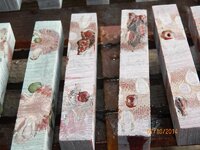robutacion
Member
Hi peoples,
Well, I couldn't tell you if, this game is better suited to older or newer turners, its all about imagination however, some experience may help...!:wink::biggrin:
Ok so, on the top of my bandsaw table, there 2 items, one is a piece of 60 grit sandpaper, and the other is a piece/off-cut of one of my Resifills (the resin part), there is a third item that is part of this question but that, I forgot to add to the pic, and that is a hammer, yes one of those tools that are made to hit nails and other stuff...!
The questions are; (it has all to do with pen turning)

What do I use these 3 items for, and how ...????
The prize is a 500gr (8 blanks) box full of goodies, you pay the shipping as normal (AU$14.00), I will think what, I'm not sure yet...!:wink:
Remember:
*- You can play but, you can't claim the prize if you have been awarded in these games, for less than 1 month.
*- You can give as many guesses as you like but, only one per post.
*- All IAP members are welcome to play.
*- If you give the best answer, you are the winner but, if you don't want to claim the prize, you will be asked to select another IAP member, regardless if that member has participated in this game or not, your decision.
*- You will asked to Paypal the cost of shipping to, nyodine@yahoo.com.au
*- If you have any questions, please don't hesitate to PM me.
*- Have fun.
Good luck...!
Cheers
George
Well, I couldn't tell you if, this game is better suited to older or newer turners, its all about imagination however, some experience may help...!:wink::biggrin:
Ok so, on the top of my bandsaw table, there 2 items, one is a piece of 60 grit sandpaper, and the other is a piece/off-cut of one of my Resifills (the resin part), there is a third item that is part of this question but that, I forgot to add to the pic, and that is a hammer, yes one of those tools that are made to hit nails and other stuff...!
The questions are; (it has all to do with pen turning)
What do I use these 3 items for, and how ...????
The prize is a 500gr (8 blanks) box full of goodies, you pay the shipping as normal (AU$14.00), I will think what, I'm not sure yet...!:wink:
Remember:
*- You can play but, you can't claim the prize if you have been awarded in these games, for less than 1 month.
*- You can give as many guesses as you like but, only one per post.
*- All IAP members are welcome to play.
*- If you give the best answer, you are the winner but, if you don't want to claim the prize, you will be asked to select another IAP member, regardless if that member has participated in this game or not, your decision.
*- You will asked to Paypal the cost of shipping to, nyodine@yahoo.com.au
*- If you have any questions, please don't hesitate to PM me.
*- Have fun.
Good luck...!
Cheers
George
Attachments
Last edited:






